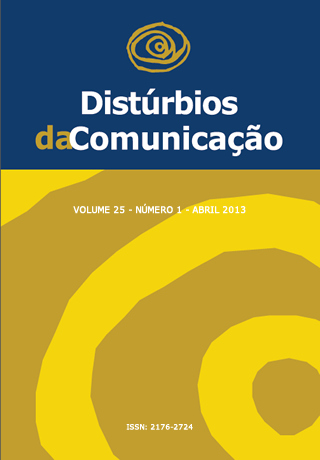The person with dysphonia: comparative analysis pre and post voice therapy program
Keywords:
voice, dysphonia, quality of life in voiceAbstract
The main purpose of a speech therapist, when facing a voice disorder is to identify its nature, defining goals and techniques to solve that problem. There is a great number of procedures to be chosen and vocal therapy program based in cognitive conceptions may provide better understanding of the optimal communication standards. Objective: to evaluate the efficacy of a voice therapy program based in cognitive conceptions, idealized for adults with functional voice disorders, stablishing results comparisons through different evaluation instruments between pre and post- therapy. Method: ten adults, one male and nine female, aged from 26 to 74 years old, took part in this study. They were making part on a waiting list from 50 people, for vocal treatment at a university school-clinic and were referred by otolaryngologists. The subjects were separated in two groups equally and submitted to eight voice therapy sessions; group A was subjected to a cognitive voice therapy program and group B (control) received traditional voice therapy. To compare the results of the program a set of assessment measures were applied, in the beginning and at the end of the voice therapy sessions, such as vocal and laryngopharyngeal symptoms prevalence, perceptual-auditory and acoustic analysis, otolaryngology evaluation, quality of life and voice protocols, Voice-Related Quality of Life VR-QOL, Voice Activity and Participation Profile (PPAV) and Voice Handicap Index (VHI). Results: Both groups showed improvement rate in the evaluated aspects, when pre and post voice therapy moments were compared. No significant differences were detected between the analyzed groups referring to the symptoms prevalence results, measures of quality of life in voice, otolaryngology evaluation and general degree of voice alteration. The acoustic analysis showed better results in spectrographic in favor of the group that received cognitive therapy. Conclusion: The speech therapy showed itself effective for both groups, without distinction regarding the applied program. The therapy program based on cognitive conceptions seem to have helped the subjects to improve their voice harmonics, in frequency as in quality.Downloads
Download data is not yet available.
Metrics
Metrics Loading ...
Downloads
Published
2013-04-27
Issue
Section
Artigos
License
Copyright (c) 2013 Iára Bittante de Oliveira

This work is licensed under a Creative Commons Attribution 4.0 International License.









